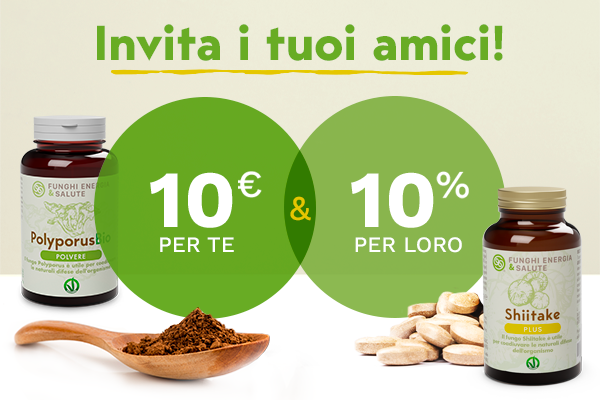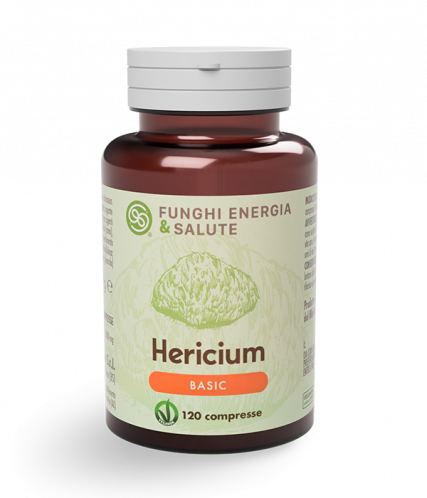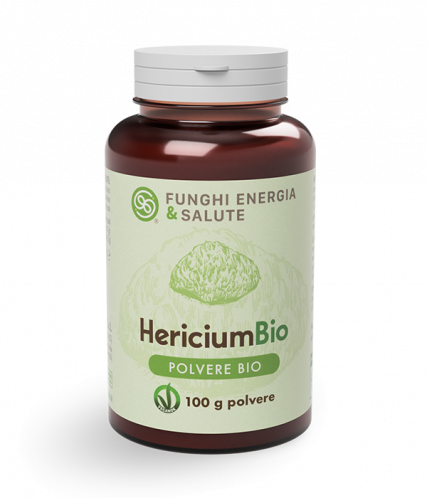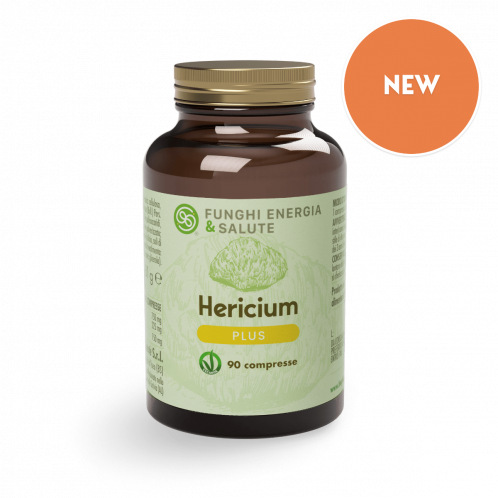Certified Natural products veganOK
030 9881073 Monday to Friday from 09:00 to 17:30
Toggle Nav 



Skip to Content
Language
EN
How can we help you?
Search
Subscribe to the Newsletter
to get immediately a discount code
on your first purchase
to get immediately a discount code
on your first purchase
Hericium
- Home
- Hericium
Hericium
In modern times
Hericium (Hericium erinaceus) is rich in erinacines, molecules that promote digestion. These substances stimulate the glands in the stomach mucosa to produce protective mucus and a normal level of acidity (Shang et al., 2013).
Important studies by Dr. Wong and other researchers of the University of Kuala Lumpur (Malaysia) have demonstrated the regeneration processes of nervous tissue, thanks to the action of Hericium on the Nerve Growth Factor present in each neuron (Wong et al., 2012 and 2014; Thongbai et al., 2015).
Ancient tradition
Hericium has been used for a long time in Traditional Chinese Medicine to treat diseases of the stomach, nervous system and nerves, as well as to strengthen energy and mental functions, to improve the immune system and restore the body's natural strength. Not only that, to highlight its benefits on physical and cognitive activities, the ancient sages coined the saying "Hericium nerves of steel and the memory of a lion".
Its fame has certainly not waned over the years: its healing properties are so strong as to have aroused the interest of many modern scientists.
Mycology
Hericium (Hericium erinaceus) is a saprophytic lignicolous mushroom which grows on the wood of old oak trees and other broad-leaved trees. It is found in Asia, Europe, North America and also in Italy.
Hericium is an edible mushroom and thanks to its excellent flavour, it is widely used and appreciated in cooking.
Chemical compounds
In Hericium there are several active ingredients, in particular:
- beta-glucans, which have an immune-stimulating and antibacterial action;
- triterpenes, essential oils able to strengthen the immune system and to fight pathogenic germs;
- polysaccharides and polypeptides, powerful anti-inflammatory and antibacterial agents, to reduce fats and cholesterol;
- erinacines, which have a germicidal effect, promote digestion, are very useful in gastritis and have a neuroprotective function;
- phenols, in particular hericenone and hericene, stimulate the nerve growth factor (NGF);
- selenium, a trace element which has been considered an essential element in daily diet since the 1950s. It is an important component within the vast group of selenium-proteins, which perform numerous antioxidant In other words, they protect cells from the harmful action, internal and external, of free radicals;
- various nutrients, such as vitamin D, lectins, particular anti-toxic fatty acids, minerals (in particular, a high potassium and phosphorus content and a low sodium content) and trace elements.
Bibliography
- Friedman M. (2015): “Chemistry, nutrition, and health-promoting properties of Hericium erinaceus (Lion’s Mane) mushroom fruiting bodies and Mycelia and their bioactive compounds.” Journal of Agricultural and Food Chemistry, 63(32): 7108-7123.
- Hua Y. (2009): “Mechanism of Hericium particles on treatment of chronic atrophic gastritis.” Medical Journal of West China, 10(4).
- Kawagishi H, Zhuang C. (2008): “Compounds for dementia from Hericium erinaceum.” Drugs of the Future, 33(2): 149.
- Kolotushkina EV, Moldavan MG, Voronin KY, Skibo GG. (2003): “The influence of Hericium erinaceus extract on myelination process in vitro.” Fiziol Zh, 49(1): 38-45.
- Kim YO, Lee SW, Kim JSA. (2014): “Comprehensive review of the therapeutic effects of Hericium erinaceus in neurodegenerative disease.” J. Mush- rooms, 12(2): 77-81.
- Mori K, Inatomi S, Ouchi K, Azumi Y, Tuchida T. (2009): “Improving ef- fects of the mushroom Yamabushitake (Hericium erinaceus) on mild cognitive impairment: a double-blind placebo-controlled clinical trial.” Phytotherapy Research, 23(3): 367-372.
- Moldavan M, Grygansky AP, Kolotushkina OV, Kirchhoff B, Skibo GG, Pedarzani P. (2007): “Neurotropic and trophic action of lion’s mane mushroom Hericium erinaceus (Bull.: Fr.) Pers. (Aphyllophoromycetideae) extracts on nerve cells in vitro.” International Journal of Medicinal Mushrooms, 9(1): 15-28.
- Nagano M, Shimizu K, Kondo R, Hayashi C, Sato D, Kitagawa K, Ohnuki K. (2010): “Reduction of depression and anxiety by 4 weeks Hericium erinaceus intake.” Biomed Res., 31: 231-237.
- Phan CW, David P, Naidu M, Wong KH, Sabaratnam V. (2015): “Therapeutic potential of culinary-medicinal mushrooms for the management of neurodegenerative diseases: diversity, metabolite, and mechanism.” Critical reviews in biotechnology, 35(3): 355-368.
- Shang X, Tan Q, Liu R, Yu K, Li P, Zhao GP. (2013): “In vitro anti- Helicobacter pylori effects of medicinal mushroom extracts, with special emphasis on the Lion’s Mane mushroom, Hericium erinaceus (Higher Basidiomycetes).” International journal of medicinal mushrooms, 15(2): 165-174.
- Thongbai B, Rapior S, Hyde KD, Wittstein K, Stadler M. (2015): “Hericium erinaceus, an amazing medicinal mushroom.” Mycological Progress, 14(10): 1-23. Wong KH, Kanagasabapathy G, Naidu M, David P, Sabaratnam V. (2014): “Hericium erinaceus (Bull.:Fr.) Pers., a medicinal mushroom, activates peripheral nerve regeneration.” Chinese journal of integrative medicine, 1-9: 427-446.
- Wong KH, Naidu M, David RP, Bakar R, Sabaratnam V. (2012): “Neuro- regenerative potential of lion's mane mushroom, Hericium erinaceus (Bull.: Fr.) Pers.(Higher Basidiomycetes), in the treatment of peripheral nerve injury (Review).” International journal of medicinal mushrooms, 14(5): 427-446.
- Yu CG, Xu ZM, Zhu QK. (1999): “Cytoprotective Effects of Hericium Erinaceus on Gastric Mucosa in Rats [J].” Chinese Journal of Gastroenterology, (2): 013.





